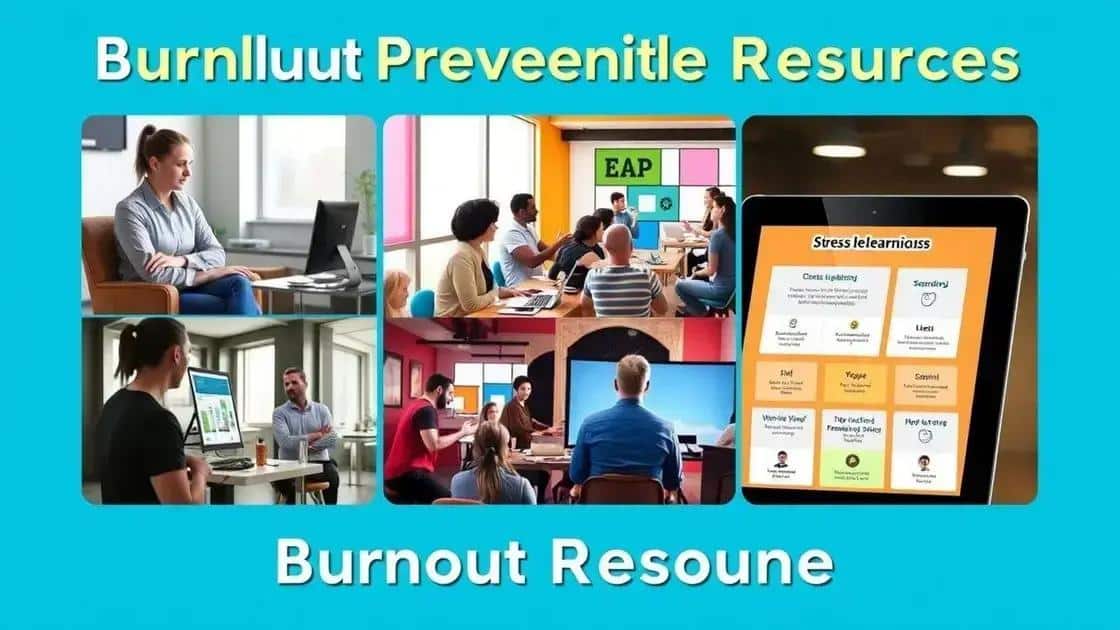Insights on workplace burnout prevention for a healthier team

Insights on workplace burnout prevention focus on strategies such as fostering open communication, promoting work-life balance, and providing resources to support employee well-being and productivity.
Insights on workplace burnout prevention are vital for maintaining a healthy work environment. Recognizing the signs of burnout can lead to better solutions and happier employees. How can we create a supportive atmosphere for everyone?
Understanding workplace burnout: causes and effects
Understanding workplace burnout is essential for fostering a healthy and productive environment. Burnout can affect anyone, and recognizing its causes and effects is the first step towards prevention.
Causes of Workplace Burnout
Several factors contribute to burnout. Here are some common causes:
- Excessive workload and unrealistic deadlines.
- Lack of control over job-related decisions.
- Poor work-life balance.
- Unresolved workplace conflict.
When employees feel overwhelmed by these challenges, their motivation can diminish, leading to significant stress. This stress, if unchecked, gradually evolves into burnout. It’s vital to recognize these signs early.
Effects of Burnout on Employees
The effects of burnout are profound and can extend beyond individual employees. It can lead to:
- Decreased productivity and engagement.
- Increased absenteeism and turnover rates.
- Negative impacts on mental health, including anxiety and depression.
A comprehensive understanding of workplace burnout helps employers grasp its implications, making it easier to implement preventive measures. Addressing burnout contributes not only to employee well-being but also to overall organizational health.
Strategies for preventing burnout in teams

To effectively prevent burnout in teams, it’s crucial to implement strategies that promote well-being and engagement. These strategies not only enhance job satisfaction but also improve overall productivity.
Fostering Open Communication
Encouraging open communication across all levels is a key element. When team members feel comfortable sharing their feelings, they are more likely to express concerns before they turn into stress.
- Regular check-in meetings.
- Anonymous feedback channels.
- Supportive management that listens.
When employees see that their voices are heard, it strengthens trust and reduces feelings of isolation.
Encouraging Work-Life Balance
A healthy work-life balance promotes mental health. Encourage your team to take breaks and respect their time off. This helps prevent overwhelming workloads.
- Set clear boundaries regarding work hours.
- Promote taking vacations and mental health days.
- Create a culture where breaks are supported.
When employees recharge, they return to work feeling revitalized and more productive. Additionally, incorporating flexible work hours can alleviate stress.
Employee training in stress management can be beneficial. Providing resources like workshops or online courses on mindfulness and resilience equips employees with tools to cope with stress. Moreover, recognizing achievements, big or small, fosters a positive atmosphere. Celebrating wins can significantly uplift morale, making employees feel valued.
With these strategies, organizations can effectively combat burnout. Building a supportive environment ensures employees are engaged and motivated.
Creating a supportive workplace culture
Creating a supportive workplace culture is vital for employee well-being and success. A positive environment allows individuals to thrive and motivates them to contribute their best work.
Building Trust and Respect
Trust is the foundation of a supportive culture. When employees trust their leaders and colleagues, they feel safe and valued. To foster trust, consider these actions:
- Encourage transparency in decision-making.
- Recognize and appreciate individual contributions.
- Provide consistent feedback and support.
Respecting diverse backgrounds and opinions also strengthens workplace bonds. This inclusivity enriches the team with various perspectives.
Encouraging Collaboration
A collaborative environment promotes teamwork, allowing members to share ideas and support one another. When employees work together, they build strong connections. Here are ways to encourage collaboration:
- Facilitate team-building activities.
- Set up collaborative workspaces.
- Implement tools that enhance communication.
When employees feel connected to their coworkers, job satisfaction increases, reducing the risk of burnout.
Lastly, prioritizing employee well-being is essential. Offering resources like wellness programs and mental health days can make a difference. By promoting self-care and understanding the importance of balance, organizations support their employees’ overall health.
Creating a supportive workplace culture leads to reduced turnover and higher levels of productivity. When employees feel valued and supported, they are more likely to stay and contribute positively to the organization.
Resources for ongoing burnout prevention efforts

Resources for ongoing burnout prevention efforts are essential for sustaining a healthy workplace. Organizations must prioritize access to tools and support.
Employee Assistance Programs (EAPs)
One effective resource is an Employee Assistance Program (EAP). These programs offer free, confidential support for employees dealing with personal or work-related issues.
- Counseling services for mental health.
- Work-life balance resources.
- Stress management workshops.
EAPs provide essential help and show employees that their well-being matters.
Workshops and Training Sessions
Regular workshops focused on stress management and resilience can empower employees. These sessions equip staff with tools to handle stress effectively.
- Mindfulness techniques.
- Time management strategies.
- Effective communication skills.
When employees learn these necessary skills, they feel more confident in managing workplace pressures.
Another valuable resource is online learning platforms. Offering courses on mental health and personal development encourages lifelong learning. This not only enhances skills but also promotes a culture of continuous improvement.
Furthermore, incorporating feedback mechanisms allows employees to express their needs. Regular surveys can gauge well-being and identify potential burnout triggers. Listening to employees demonstrates a commitment to their needs and fosters a supportive environment.
Lastly, creating a wellness library with articles and resources on stress relief, nutrition, and work-life balance can provide ongoing support. By continuously offering various resources, organizations reinforce their dedication to preventing burnout.
In conclusion, preventing workplace burnout is essential for fostering a healthy and productive environment. By implementing strategies such as open communication, collaboration, and support resources, organizations can create a culture that values employee well-being. Regularly investing in training and wellness programs helps equip employees with the tools they need to manage stress effectively. Ultimately, a supportive atmosphere encourages engagement, boosts morale, and enhances overall performance. It’s crucial for every organization to prioritize these efforts for a sustainable and thriving workplace.
FAQ – Questions about Workplace Burnout Prevention
What are the main causes of workplace burnout?
The main causes include excessive workload, lack of control, poor work-life balance, and unresolved conflicts.
How can organizations support their employees to prevent burnout?
Organizations can support employees by fostering open communication, promoting a collaborative culture, and offering resources like Employee Assistance Programs.
What role do training sessions play in preventing burnout?
Training sessions equip employees with stress management skills and resilience techniques, helping them cope with workplace pressures.
Why is feedback important in addressing burnout?
Feedback helps organizations identify employee needs, improving the work environment and reducing the risk of burnout.





